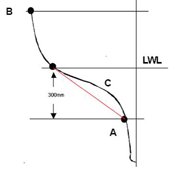The International Twopointfourmetre Class
This homepage is built and maintained by Hasse Malmsten.
Metre rule explained
Here’s an attempt to explain the meter rule for those who are not familiar with it.
Regard it as an ongoing project. Maybe the best help I can get is that you who read it ask me whatever
questions that arise as you read and try to get into the text.
Later a description of the measurement procedure will follow.
If you are not familiar with the rule it’s good if you tell me what could be explained better.
If you are familiar with the rule you probably have something to add too.
The metre rule in its relative simplicity typeforms the boats built to the rule into a certain design space
by penalizing what it views as non acceptable excessive shapes and measures/control the speed enhancing
factors for a heavy displacement type of yacht.
For a displacement boat like the 2,4mR, speed is mainly a function of waterline length.
Speed to Length Ratio = velocity in knots/Sq root of waterline length = v/sq root of lwl.
This is the speed that a pair of waves can move through the water. Above this speed the boats begins
to try to climb its bow wave.
The maximum speed is ordinarily considered to be 1.34 times the square root of the LWL in feet
(2,34x the sq root of LWL in metres).
The length measurement L in the rulemeasures the assumed length while under speed and the distribution
of the volume of the under water body and thus measures maximum attainable speed.
For the 2,4mR class the L is the length measured 36mm above the waterline the boat floats at in measurement
trim plus a measurement of the volume of the ends of the boat, the girth measurements.
The speed potential of the hull is then balanced against the size of the sails (power available).
The longer the boat (the higher the potential max speed) the less sails you can have.
The principal variations you can play with within the rule are the length that rules maximum attainable speed
and sail area that rules maximum accessible power.
This is the centrepiece of the metre rule.
Most of the other limitations are there to type form the boats into a specific design space.
The major type forming limitations are as follows:
The minimum displacement is calculated from the waterline length with a formula. Not satisfying the minimum dpl causes a heavy penalty added to the measured length.
With the 3 girth measurements the shape/fullness of the forward, middle and aft sections are measured/controlled.
The forward girth has a limit value that is costly to exceeded as the girth difference is multiplied by 1,5 and added to the measured length, and you are not allowed to profit from a lower value.
The mid section shape is controlled by the mid girth measurement that is the difference between the length of a cord following the skin of the hull vertically from the sheer to a point 300 mm below the waterline and a cord taking the shortest path to the same point ie. a wineglass section with the thin part above the 300 mm point. The difference from both sides is doubled and added to the measured length.
The aft sections are controlled by the aft girth measurement that measures the fullness of these sections. The aft girth difference shall not be less than 240 mm. Fullness aft is not penalised as heavily as when diverging from the norm on the other two girth measurements as the girth measurement is divided by 3 before added to measured length.
Another type forming limitation is that the hull above the waterline shall have no hollows in the surface between the lwl plane and the sheer line except at the stern within the buttock lines 100mm from the yachts centreline and below L1.
The maximum draft without penalty shall be 1000mm.
The minimum average freeboard shall not be taken as more than 292 mm in the formula.
There are some more limitations but these are the major ones that type forms the shape of the hull.



